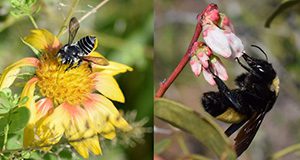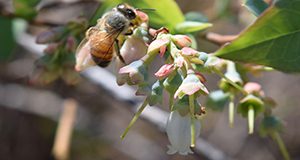Squash and pumpkin (Cucurbita spp.) are economically significant crops in Florida with over 7,900 acres in production and an estimated value of $35,412,000. Without insect pollination, however, crop yields for zucchini, crookneck, spaghetti, butternut and the rest of the large and delectable crew of squash and pumpkin species grown in Florida would be low to nonexistent. This 7-page fact sheet written by Rachel E. Mallinger and Oscar E. Liburd and published by the UF/IFAS Entomology and Nematology Department explains the pollination biology and requirements for squash and pumpkin, describes the signs and causes of poor pollination, and provides recommendations for improving pollination of these crops in Florida.
https://edis.ifas.ufl.edu/in1311
Tag: Rachel E. Mallinger
Bees of Florida
Did you know there are over 320 species of bees in Florida and over 4,000 in the United States? Wild bees vary widely in behavior, color, size, and shape. Written by James R. Weaver, Shiala M. Naranjo, Emily Noordyke, and Rachel E. Mallinger and published by the UF/IFAS Entomology and Nematology Department, Bees of Florida is a two-page pdf guide to some common bee groups and species you may encounter in Florida.
https://edis.ifas.ufl.edu/in1285
Attracting Native Bees to Your Florida Landscape
Florida is home to approximately 315 species of native wild bees. These bees rely on flowers for survival; their diets consist exclusively of pollen and nectar harvested from flowers. Recently reported declines in some bee species have heightened awareness of bee conservation across the United States and motivated efforts to increase floral resources for bees. This 7-page fact sheet written by Rachel E. Mallinger, Wayne Hobbs, Anne Yasalonis, and Gary Knox and published by the UF/IFAS Entomology and Nematology Department shows how gardeners and land managers can aid in conservation efforts by planting flowers for bees in home or community gardens.
http://edis.ifas.ufl.edu/IN1255
Pollination Best Practices in Southern Highbush Blueberry in Florida
Southern highbush blueberry is the primary blueberry species grown in Florida. It is dependent upon pollinating insects for adequate pollination and fruit. Some Florida growers have reported cases of low fruit set in recent years, in particular on the cultivars Meadowlark and Emerald, which may have been due in part to poor pollination. This 5-page fact sheet written by Rachel E. Mallinger and Douglas A. Phillips and published by the UF/IFAS Department of Entomology and Nematology will discuss blueberry pollinators, some causes of poor pollination, and current best practices to reduce the possibility of poor pollination of southern highbush blueberry.
http://edis.ifas.ufl.edu/in1237


